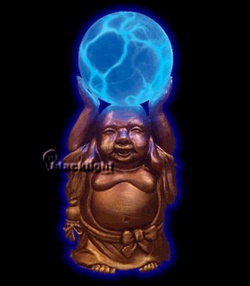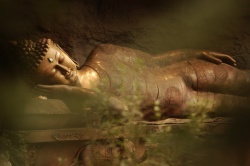Meditation of the three inner and outer tantras by Kunkhyen Tenpe Nyima
1. The three outer tantras from the Notes on Development stage - Compendium of the Key Instructions:
Resting in the nature of mind states:
"Kriya tantra approaches oneself to be inferior and a deity as supreme. Thus, one accomplishes the siddhi in the way of master and servant. In Charya tantra a deity and one self are seen as equal. One visualizes a wisdom deity in front of one self, samaya being, and receives the siddhi like a friend. In the main part of Yoga tantra practice a deity and one self are inseparable from each other. In preparatory and concluding ritual a deity and one self are separated while the deity is invoked and sent back to its abode. Receiving the siddhi is non dual like pouring water into water.”
Even though one does not visualize one self as a deity in the ordinary Kriya tantra, in specific cases one self is visualized as a wisdom deity and seen as a king. The ritual of cleaning by the manner of washing one self, the samaya being that is the servant him self, became main practice in outer Kriya tantra. It is clamed that one receives the siddhi by practicing in such way.
Tantra of receiving the siddis of all buddha families states:
“Having seen the master as deity in form of the king and having a perception of the servant as of own self, one recites mantra and receives the essence of siddhi that is the supreme unsurpassable enlightenment.”
In the Charya tantra the view accords with the Yoga tantra and the conduct accords with the Kriya tantra. Having practiced on the basis of equalizing these two and visualized oneself as samaya being and a wisdom deity in front one receives the siddhi in the manner of a relative or a friend.”
Common Tantra of the three Buddha families stays:
“One will receive superior siddhi simply in the way of a relative or a friend.”
In the Yoga tantra one visualizes oneself as a deity, invokes a wisdom being and by absorbing it into one self, they become inseparable. At the end of offering, praising and reciting mantra having received the siddhi a wisdom being is requested to depart into its abode.
The Vajra element states:
“Receiving sacred unsurpassable siddhi and abiding in the dharmadhatu of non-duality.”
2. Meditation of the three inner tantras
Resting in the nature of the mind states:
“Mahayoga emphasize the aspect of method: meditative practice of the subtle winds and development stage. Anuyoga emphasizes the aspect of wisdom: meditative practice of elements and completion stage. In Atiyoga is fundamental non-dual wisdom of all phenomena. All the three tantras practice by means of knowing that all phenomena are since the beginning equal in their nature.”
In Mahayoga, having relied on the three samadhis, one meditates on inseparability of the concept and deity by developing the mandala gradually. In Anuyoga is asserted that all phenomena are having nature of the inseparability of the three mandalas. The root mandala of enlighten mind arises as body of deity, unobstructed manifesting power of the display of the primordial buddha Samantabadra.
Magical key of the treasurer states:
“It is claimed that in perfect Anuyoga aggregates and sense sources are perfected as male and female deities of mandala without generating them. In Anuyoga vehicle having pronounced mere seed syllable, one meditates on completed deity without generating it.”
Compendium states:
“The outer, inner and secret mandalas that were arranged are all pervasive primordial great perfection of Samantabhadara.”
In Atiyoga appearance is father, emptiness is mother and awareness is their child. From tregchod dependently arises assembly of the forms of the deities that are potential of awareness, the aspect of thogal. Concentrate on the clear appearance of the deity that is great purity and equanimity thoroughly established by spontaneous manifestation, the unobstructed energy. That is similar to main sadhana of Innermost essence cycle.
From the commentary on the Eight Sadhanas:
“In Mahayoga meditate on appearance and existence as being mandala deity. According to Anuyoga all these appearances and existences are completely perfected within the mandala of vajra body. In Atiyoga everything is perfected with the mandala of the mind.”
Moreover regarding the differences between the outer and inner mantra vehicle Embodiment of realization states:
“In outer tantra the male and female consorts of the deity are the seed syllables and the vital essence of the practices of completion stage. In inner tantra the union of the deities is the consort practice of completion stage. As for the ornaments, deities of outer tantra are adorned with the precious head ornaments while deities in inner tantras have bone ornaments. In outer tantra are offered the three white substances while in inner tantra five types of flesh and nectars. Outer tantra uses a prescious vessel while inner tantra a skull cup. The aspects that are common for both are torma and burned offering, consecration rituals, tsa tsa and vase consecration.”
It is said in the commentary to a tantra that:
“One who mastered the practice of twenty phenomena of samsara is called the inner tantra practitioner.”
It is said that, the main phenomena of samsara are the four types of rebirth because they arise in dependence on rebirth in samsaric existence and appear as phenomenal variety of samsara. Therefore one practices the four meditations of the development stage in order to purify habitual tendencies of four types of rebirth.
A tantra states:
“In order to purify the four types of rebirth there are four kinds of meditation that accords with the development stage: meditation of mere mental elaboration, partial elaboration, without elaboration and completely free of any elaboration.”
Embodiment of realization states:
“Practitioner with high capacity recognizes uncontrived self-originated primordial clarity, spontaneous presence and complete purity free of elaborations as the essence of the deity. Practitioner with medium capacity recognizes the self-originating energy of compassion that is uncompounded and devoid of defining characteristics as luminous deity with pure channels and elements. Practitioner with low capacity recognizes all apparent forms as male and female deities visualized from the non-conceptual state like a fish is leaping from the water. Having pure faith and samaya the visualization arises clearly by means of the five of manifestation and the three samadhis.”
Tantra of the lotus stems piled up states:
“One should understand that all detailed explanations spoken in terms of the nine fold divisions etc. are made in by further dividing each capacity, hight, medium and low, into other three. This can be found in other texts.”
Translated from Tibetan October 2011

